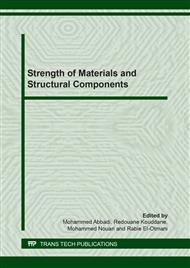[1]
F. Klocke, T. Krieg, Coated Tools for Metal Cutting-Features and Applications. CIRP Annals – ManufacturingTechnology. 48(2) (1999) 515–525.
DOI: 10.1016/s0007-8506(07)63231-4
Google Scholar
[2]
C. Pagès, Comportement de revêtements céramiques sur outil en tournage à sec de finition. Mécanique.France, EcoleCentrale Lyon. (2003).
Google Scholar
[3]
A. A VereschakaaS, N. Grigorieva, N.N. Sitnikovbc, A.D. Batakod, Delamination and longitudinal cracking in multi-layered composite nano-structured coatings and their influence on cutting tool life, Wear. 390–391 15 (2017) 209-219.
DOI: 10.1016/j.wear.2017.07.021
Google Scholar
[4]
E.J. Oles, A. Inspektor, C.E. Bauer, Diam. Relat. Mater. 5(1996)617.[5] J.M. Sanchez, S. El-Mansy, B. Sun, T. Scherban, N. Fang, D. Pantuso, W. Ford, M.R. Elizalde, J.M. Martinez-Esnaola, A. Martin Meizoso, J. Gil-Sevillano, M. Fuentes, J. Maiz, ActaMater.47(1999)4405. [6] R. Polini, P. D'Antonio, S. Lo Casto, V.F. Ruisi, E. Traversa, Surf. Coat. Technol. 123(2000).
DOI: 10.1016/s1359-6454(99)00254-2
Google Scholar
[7]
F. Qin, N.Shen, Y.K. Chou, Implementing a cohesive zone interface in adiamond-coated tool for 2D cutting simulations, imece.(2012)88640.
DOI: 10.1115/imece2012-88640
Google Scholar
[8]
F. Qin a, Y.K. Chou a,*, D. Nolen b, R.G. Thompson b, Coating thickness effects on diamond coated cutting tools, Surface & Coatings Technology. 204 (2009) 1056–1060.
DOI: 10.1016/j.surfcoat.2009.06.011
Google Scholar
[9]
P. Lu a, X. Xiao b, M. Lukitsch b, A. Sachdev b, Y.K. Chou a,* Interface characterizations of diamond-coated tools by scratch testing and simulations, Surface & Coatings Technology. 206 (2011) 1860–1866.
DOI: 10.1016/j.surfcoat.2011.08.022
Google Scholar
[10]
P. Lu a, G. Humberto b,d, X. Xiao c, M. Lukitsch c, D. Durham b, A. Sachdeve c, A. Kumar b, K. Chou a, Coating thickness and interlayer effects on CVD-diamond film adhesion to cobalt-cemented tungsten carbides Surface & Coatings Technology. 215 (2013) 272–279.
DOI: 10.1016/j.surfcoat.2012.08.093
Google Scholar
[11]
P. Lu a, X. Xiao b, Y.K. Chou a Interface delamination study of diamond-coated carbide tools considering coating fractures Surface & Coatings Technology. 260 (2014) 239–245.
DOI: 10.1016/j.surfcoat.2014.08.080
Google Scholar
[12]
D. S. Dugdale, J. Mech. Phys. Solids. 8 (1960) 100–104.
Google Scholar
[13]
G. I. Barenblatt, Advan. Appl. Mech. 7 (1962) 55–125.
Google Scholar
[14]
A.C. Palmer, J.R. Rice, The growth of slip surfaces in the progressivefailure of overconsolidated clay. Proceedings of the Royal Society, London. (1973) A332, 527-548.
Google Scholar
[15]
A. Hillerborg, M. Modéer, P. E Petersson, Analysis of crack formation and crack growth in concrete by means of fracture mechanics and finite elements, Cement and Concrete Research. 6 (1976) 773-782.
DOI: 10.1016/0008-8846(76)90007-7
Google Scholar
[16]
G.T. Camacho, M. Ortiz, Computatio nalmodelling of impact damage in brittle materials. Solids 5 Structures. 33(1996) 20–22.
Google Scholar
[17]
R.D.S.G. Campilho, M.F.S.F. de Moura, J.J.M.S. Domingues, Computitational modelling of the residual strength of repaired composite laminates using a cohesive damage model. 22(2008)1565-1591.
DOI: 10.1163/156856108x309576
Google Scholar
[18]
L. Cangémi, M. Cocu, M. Raous, g g Adhesion and friction model for the fibre/matrix interface of a composite h h, Third biennal Joint Comference on engineering system design and analysis, Montpellier. 1-4 (1996) 157-163.
Google Scholar
[19]
M. Raous, L. Cangémi, M. Cocu, g g Un modèle couplant adhérence et frottement pour le contact unilatéral entre deux solides déformables h h , C. R. Acad. Sci. Paris. 329 (1997) 503-509.[20] M. Raous, L. Cangémi, M. Cocu, g g Consistent model coupling adhesion, friction and unilateral contact h h, Computer Meth. Appl. Mech. and Engrg. 177(1999)383-399.
DOI: 10.1016/s1251-8069(97)89074-4
Google Scholar
[21]
A. Needleman. An analysis of tensile decohesion along an interface. Mech. Phys. Solids. 38(1989)289–324.
Google Scholar
[22]
V. Tvergaard. Eect of fibre debonding in a whisker-reinforced metal. Material Science and Engineering Part. 125 (1990)203–213.
DOI: 10.1016/0921-5093(90)90170-8
Google Scholar
[23]
P. H. Geubelle and J. S. Baylor. Impact-induced delamination of composites: a 2d simulation. Composites Part B, 29B :589–602, (1998).
DOI: 10.1016/s1359-8368(98)00013-4
Google Scholar
[24]
N Moës, J Dolbow, T Belytschko. A finite element method for crack growth with out remeshing. International Journal of Numerical Methods in Engineering. 46 (1999) 131-50.
DOI: 10.1002/(sici)1097-0207(19990910)46:1<131::aid-nme726>3.0.co;2-j
Google Scholar
[25]
T Belytschko, T Black. Elastic crack growth in finite elements with minimal remeshing. International Journal of Numerical Methods in Engineering 1999; 45:601-20.[26] T.P Fries, T Belytschko. The extended/generalized finite element method: An over view of the method and its applications. International Journal for Numerical Methods in Engineering 2010; 84: 253-304.
DOI: 10.1002/(sici)1097-0207(19990620)45:5<601::aid-nme598>3.0.co;2-s
Google Scholar
[27]
T Belytschko, R Gracie, G Ventura. A review of extended/ generalized finite element methods for material modeling. Model Simul Mater Sc 2009; 17(4): 043001. [28]P Lu, K Chou. Interface delamination of diamond-coated carbide tools considering coating fractures by XFEM. (2013).
DOI: 10.1115/msec2013-1132
Google Scholar
[29]
P. Lu, An investigation into interface behavior and delamination wear for diamond-coated cutting tools, Doctoral thesis, Tuscaloosa, Alabama. (2013).
Google Scholar


